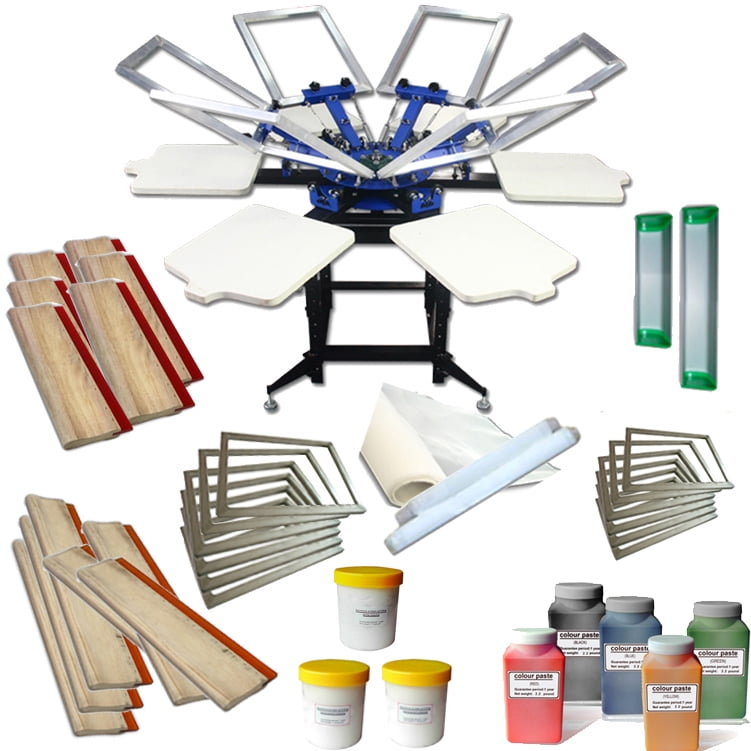Screen Printing Supplies: Everything You Need to Know

Types of Screen Printing Supplies
Screens
The screen is the backbone of the screen printing process. It is a mesh stretched over a frame that holds the stencil or design. There are various types of screens, including aluminum, wood, and steel frames. Each type of screen has its advantages and disadvantages.
Aluminum Frames
Aluminum frames are the most popular choice for screens. They are lightweight, durable, and easy to clean. Aluminum frames are also resistant to warping and have a longer lifespan than other types of frames.
Wooden Frames
Wooden frames are a more affordable option than aluminum frames. They are ideal for beginners or those on a tight budget. However, wooden frames are less durable than aluminum frames and tend to warp over time.
Steel Frames
Steel frames are the most durable and long-lasting type of frame. They are ideal for high-volume production runs and heavy-duty printing. However, steel frames are heavy, making them difficult to handle and transport.
Inks
Inks are the most important part of the screen printing process. They are responsible for creating the design on the garment. There are various types of inks, including water-based, plastisol, and discharge inks. Each type of ink has its advantages and disadvantages.
Water-Based Inks
Water-based inks are eco-friendly and easy to work with. They are ideal for printing on light-colored garments and produce a soft hand feel. However, water-based inks are not suitable for dark-colored garments and require special equipment for curing.
Plastisol Inks
Plastisol inks are the most common type of ink used in screen printing. They are easy to work with and produce vibrant colors. Plastisol inks are also suitable for printing on dark-colored garments and require heat curing.
Discharge Inks
Discharge inks are used to remove the dye from the garment and replace it with the desired color. They are ideal for printing on dark-colored garments and produce a soft hand feel. However, discharge inks require special equipment for activation and are not suitable for all fabrics.
Squeegees
Squeegees are used to apply the ink to the screen and transfer it onto the garment. There are various types of squeegees, including wooden, aluminum, and ergonomic squeegees. Each type of squeegee has its advantages and disadvantages.
Wooden Squeegees
Wooden squeegees are the most affordable option. They are ideal for beginners or those on a tight budget. However, wooden squeegees are less durable than other types of squeegees and tend to warp over time.
Aluminum Squeegees
Aluminum squeegees are lightweight, durable, and easy to clean. They are the most popular type of squeegee used in screen printing. Aluminum squeegees are also suitable for high-volume production runs.
Ergonomic Squeegees
Ergonomic squeegees are designed to reduce hand fatigue during the printing process. They have an angled handle that provides a comfortable grip and reduces wrist strain. Ergonomic squeegees are ideal for long printing sessions.
Emulsion
Emulsion is a light-sensitive liquid that is used to create the stencil or design on the screen. There are two types of emulsion, including water-based and solvent-based emulsion. Each type of emulsion has its advantages and disadvantages.
Water-Based Emulsion
Water-based emulsion is eco-friendly and easy to clean. It is ideal for beginners or those who are new to screen printing. However, water-based emulsion is less durable than solvent-based emulsion and tends to break down more quickly.
Solvent-Based Emulsion
Solvent-based emulsion is more durable than water-based emulsion and can withstand multiple print runs. It is ideal for high-volume production runs and heavy-duty printing. However, solvent-based emulsion is more difficult to clean and requires special equipment for disposal.
The Advantages and Disadvantages of Screen Printing Supplies
Advantages
- Screen printing produces vibrant colors and sharp designs.
- Screen printing is suitable for printing on a wide range of fabrics and materials.
- Screen printing is a cost-effective printing method for high-volume production runs.
- Screen printing is durable and long-lasting.
Disadvantages
- Screen printing requires specialized equipment and supplies.
- Screen printing is not suitable for small print runs or one-off designs.
- Screen printing can be time-consuming and labor-intensive.
- Screen printing requires a high level of skill and expertise to achieve high-quality results.
FAQs
1. What is screen printing?
Screen printing is a printing technique that involves transferring ink onto a surface through a mesh screen. It is widely used in the textile industry for printing designs on t-shirts, hoodies, and other garments.
2. What supplies do I need for screen printing?
You will need screens, inks, squeegees, and emulsion to get started with screen printing. You may also need other supplies, such as a light table, exposure unit, and washout booth, depending on your printing setup.
3. Can I screen print at home?
Yes, you can screen print at home with the right equipment and supplies. However, screen printing requires a certain level of skill and expertise, so it may take some practice to achieve high-quality results.
4. What is the difference between water-based and plastisol inks?
Water-based inks are eco-friendly and produce a soft hand feel, while plastisol inks are more vibrant and suitable for printing on dark-colored garments. Water-based inks require special equipment for curing, while plastisol inks require heat curing.
Conclusion
Screen printing supplies are essential for creating high-quality designs on garments and other materials. From screens and inks to squeegees and emulsion, each type of supply plays a crucial role in the screen printing process. Whether you are a beginner or an experienced printer, understanding the different types of supplies and their advantages and disadvantages can help you achieve the best results.
